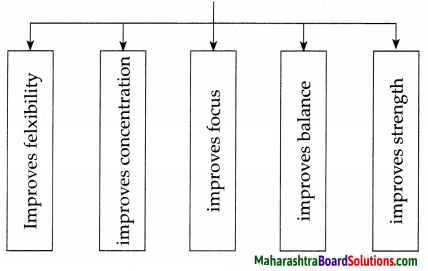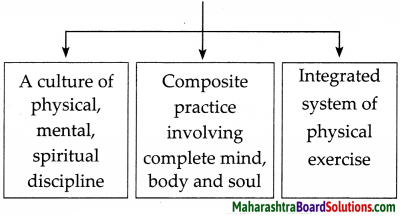Balbharti Maharashtra State Board Class 7 English Solutions Chapter 2.5 Learn Yoga from Animals Notes, Textbook Exercise Important Questions and Answers.
Maharashtra State Board Class 7 English Solutions Chapter 2.5 Learn Yoga from Animals
Class 7 English Chapter 2.5 Learn Yoga from Animals Textbook Questions and Answers
1. Complete the following diagrams.
Question A.
Benefits of yoga.

Answer:

Question B.
Precautions in Yoga Practice

Answer:

Question C.
What is yoga?

Answer:

2. Prepare charts for each one of the asanas described in the passage. Use the following points:
- Name (in English, in your mother tongue)
- Meaning in English
- General information
- Steps and pictures
- Benefits
![]()
3. List the names of body parts used in the passage.
Question 1.
List the names of body parts used in the passage.
Answer:
Body parts – navel, spine, shoulder, palm, face, elbow, wrist, chin, abdomen, chest, fingers, jaws, feet, legs, toes, eyes, mouth, head, back, tongue, lungs.
Now go through the passage and find out some more and add to the list.
4. List the adverbs/adverbial phrases used in the passage.
Question 1.
List the adverbs/adverbial phrases used in the passage.
Answer:
- to feel physically vibrant
- feel mentally sharp
- completely at ease
- breathe in deeply
- slowly raise
- come up slowly
- come down slowly
- inhale immediately
- positioned directly below
- smoothly arch the spine
- adds flexibility
- simultaneously arch your back
![]()
5. Language Study: Conjunctions: A conjunction is a word which joins words or clauses. Look at the following sentences.
1. Sahil and Rohan go to school together.
2. Sahil is drawing a picture and Rahul is playing football.
In sentence 1, the conjunction ‘and’ joins two words.
In sentence 2, the conjunction ‘and’ joins two clauses.
The following are some more examples of conjunction.
- Do you like cricket or football?
- Your parents will be happy if you study well.
- She has not come to school because she is ill.
- We played well, but we lost the match.
- Tell him that we are going to the playground.
- When you are at home, you should help your mother in her work.
Interjections: An interjection is a word that expresses a sudden feeling or emotion. Interjections can express joy, grief, surprise, pain, approval etc.
Look at the following examples.
- Hurrah! We have won the game. (Joy)
- Ouch! That hurt. (Pain)
- Wow! What a nice picture! (Approval)
Question 1.
Underline the conjunctions in the following.
Answer:
- Do you like cricket or football?
- Your parents will be happy if you study well.
- She has not come to school because she is ill.
- We played well, but we lost the match.
- Tell him that we are going to the playground.
- When you are at home, you should help your mother in her work
Class 7 English Chapter 2.5 Learn Yoga from Animals Additional Important Questions and Answers
Answer the following questions.
Question 1.
Where was yoga perfected?
Answer:
Yoga was perfected in ancient India.
Question 2.
What does yoga involve?
Answer:
Yoga involves the mind, body and soul.
![]()
Question 3.
What are the benefits of yoga?
Answer:
The benefits of yoga are attaining concentration, focus and improving flexibility, balance and strength.
Question 4.
How does one feel after doing yoga?
Answer:
One feels physically vibrant and mentally sharp after doing yoga.
Question 5.
Who enjoys the Lion pose asana? Why?
Answer:
Simhasana or Lion pose is favourite with young people. Young people love this asana because it requires very little effort.
Question 6.
What pose does the Bhujangasana resemble?
Answer:
The Bhujangasana is a pose that resembles the posture of a cobra with raised head.
Question 7.
What are the benefits of Bhujangasana? .
Answer:
Bhujangasana helps us to tone the muscles of our back, strengthens our spine and also benefits the chest and shoulders.
![]()
Question 8.
When does the world celebrate International Yoga Day?
Answer:
The world celebrates International Yoga Day on June 21st every year, since the year 2015.
Question 9.
Why should Marjaryasana be a part of one’s morning yoga routine?
Answer:
Marjaryasana should be a part of one’s morning yoga routine because it gently stretches the muscles of the abdomen and the back as well as helps to get rid of any body pain.
Question 10.
How does Garudasana benefit the legs?
Answer:
Garudasana makes the leg muscles stronger and improves the flexibility of joints by loosening the joint muscles.
Question 11.
What are the advantages of practising the Ustrasana?
Answer:
- It strengthens the back.
- It boosts mood and energy.
- It opens the shoulders, chest and quadriceps.
- It helps in improving digestion.
- It adds flexibility and strength to the body.
Question 12.
Do you exercise regularly? What form of exercise do you practice ?
Answer:
I exercise regularly as my parents have always motivated me to stay fit. I go to the local swimming pool everyday to swim in the evening. Swimming is refreshing for the mind and helps to maintain the overall fitness of one’s body.
![]()
Reading Skills, Vocabulary and Grammar
Read the following passage and do the activities.
Question 1.
Complete the web diagram.

Question 2.
Fill in the blanks.
i. Yoga is a form of…….
ii. Yoga helps us to feel physically vibrant and mentally ……..
Answer:
i. biomimicry
ii. sharp
Question 3.
Match the columns.
| Column ‘A’ | Column ‘B’ |
| 1. Phvsicallv | a. area |
| 2. Ancient Indian | b. sharp |
| 3. Contemporary | c. discipline |
| 4. Mentally | d. vibrant |
Answer:
| Column ‘A’ | Column ‘B’ |
| 1. Phvsicallv | d. vibrant |
| 2. Ancient Indian | c. discipline |
| 3. Contemporary | a. area |
| 4. Mentally | b. sharp |
![]()
Answer in just one word:
Question 1.
What solves human problems with solutions already present in the natural world?
Answer:
Biomimicry.
Complex Factual Questions:
Question 1.
What is biomimicry?
Answer:
Biomimicry is the science of solving human problems with solutions already present in the natural world.
Question 2.
In what way is yoga a form of biomimicry?
Answer:
Yoga is a form of biomimicry because they comprise typical asanas and poses wherein we emulate mountains, trees, fish, cats and many more animals.
Question 3.
Which problems in our day-to-day life can be solved through biomimicry?
Answer:
Problems such as stiffness and back pain can be easily solved through biomimicry.
![]()
Question 4.
What does biomimicry mean in simple terms?
Answer:
In simple terms, ‘bio’ means ‘life’ and ‘mimicry’ means ’emulate’.
Vocabulary:
Question 1.
Give forms of the following words.
Answer:
| Noun | Verb | Adjective |
| Nature | Naturalise | Natural |
| Simplicity | Simplify | Simple |
| Sharpness | Sharpen | Sharp |
Question 2.
Pick out a word from the extract which means ‘in the same time period’.
Answer:
Contemporary.
Grammar:
Question 1.
Experts today are doing a wonderful job. (Begin with ’A wonderful job’)
Answer:
A wonderful job is being done by the experts today.
![]()
Question 2.
This helps us to solve our problems. (Add a question tag)
Answer:
This helps us to solve our problems, doesn’t it?
Personal Response:
Question 1.
Do you think it is necessary to exercise? Why?
Answer:
Yes. I do think it is necessary to exercise. Exercising keeps us fit and healthy. We feel active and fresh to meet the challenges of the day. It also keeps us mentally positive.
Language Study
Do as directed.
Question 1.
The best time to practise is in the morning. (Begin with ‘The morning’)
Answer:
The morning is the best time to practise.
Question 2.
Practise in a clean, airy, well-lit room. (Pick out the adjectives in the sentence)
Answer:
Clean, airy, well-lit.
![]()
Question 3.
Relax your muscles completely. (Identify the kind of sentence)
Answer:
Imperative sentence.
Question 4.
Kneel on the yoga mat and place your hands on the hips. (Pick out the nouns)
Answer:
Mat, hands, hips.
Fill in with conjunctions.
Question 1.
This is the picture ……….. I painted yesterday.
Answer:
that
Question 2.
We met the sailors ……….. ship was wrecked.
Answer:
whose
![]()
Question 3.
This is the girl ………… has a melodious voice.
Answer:
who
Question 4.
………….. you study hard, you will succeed.
Answer:
If
Question 5.
………… it rains heavily, life comes to a standstill.
Answer:
When.
Question 6.
Give examples of interjections.
Answer:
- Oops! I broke it. (mistake)
- Hushi/Shh! The baby is sleeping, (silence)
- Hey! What are you doing here? (surprise)
- Oh! You wanted tea and not coffee, (realisation)
- Ugh! What a foul smell! (disgust)
- Phew! We nearly missed the fall! (relief)
- Whew! I cannot believe we have completed on time, (relief/amazement)
Fill in with interjections.
Question 1.
………… ! You stamped my foot.
Answer:
Ouch
![]()
Question 2.
………… ! If only I had listened.
Answer:
Oh
Question 3.
………… ! It looks horrible.
Answer:
Ugh
Question 4.
………… ! I spilled the milk.
Answer:
Oops
Question 5.
………… ! What a pretty dress!
Answer:
Wow
Learn Yoga from Animals Summary in English
The lesson aptly shows us how we can do yoga by imitating animals and reptiles. It tells us the benefits and ways one can remain fit and healthy.
Introduction:
Yoga is a physical, mental and spiritual practice attributed mostly to India. Yoga day is celebrated annually on 21st June since 2015. The United Nations General Assembly has declared this day, 21st June to be an international day for yoga. The Indian Prime Minister, Narendra Modi, in his U.N. address suggested the date of 21st June as it is the longest day of the year in the Northern Hemisphere.
![]()
Glossary:
- emulate (v) – imitate
- vibrant (adj) – full of energy and life
- posture (n) – the position in which you hold your body while sitting or standing
- tone (v) – here it means to make the muscles firm
- navel (n) – belly button
- assume (v) – here it means ‘take’
- splayed (v) – spread apart
- quadriceps (n) – the large muscle at the front of the thigh
- composite (adj) – mixture of
- integrated (adj) – composed and co-ordinated
- contemporary (adj) – same time period
- discipline (n) – a specific branch of knowledge or learning
- jerk (n) – sudden uncontrolled movement
- vertebra (n) – small bones which make up the backbone
- palette (n) – roof of your mouth
- exhaling (v) – to expel air
- inhale (v) – to draw in air
- routine (n) – a course of action
- flexibility (n) – quality of being flexible, suppleness
- calf (n) – the muscle in the back of the leg below the knee
- aches (n) – continuous dull pains in a part of one’s body
- arch (n) – a curve with the ends down and the middle up
- drawing (v) – to direct one’s attention to something
- explosion (n) – a sudden burst
- biomimicry – the science of solving human problems with solutions already present in the natural world.